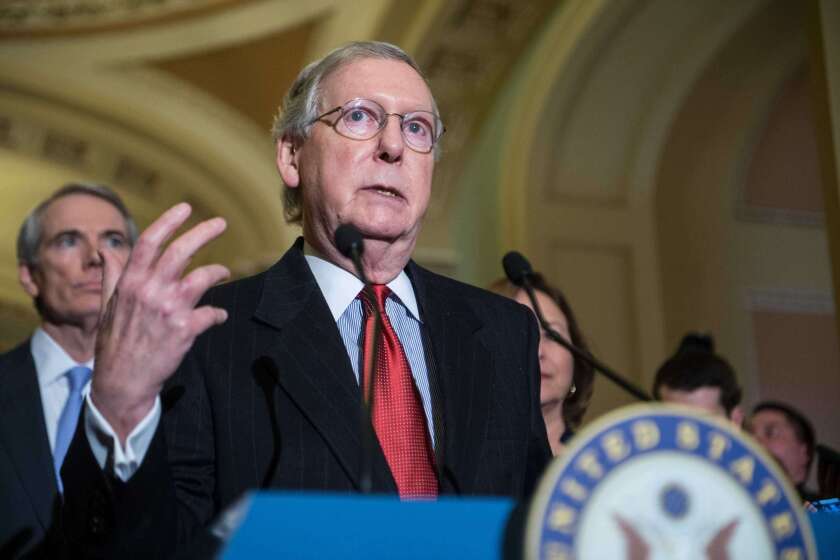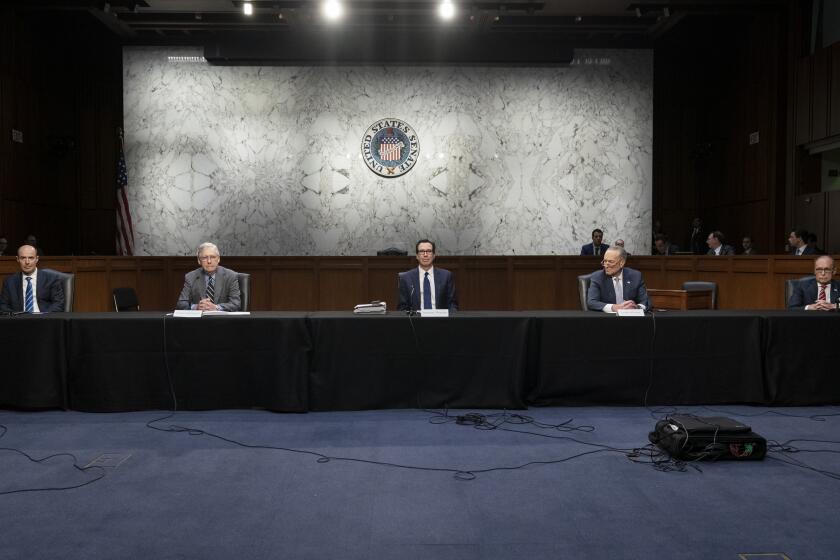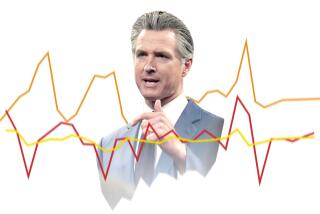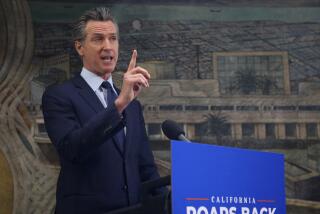Column: McConnell says there’s no need for more state and local aid. Don’t believe him
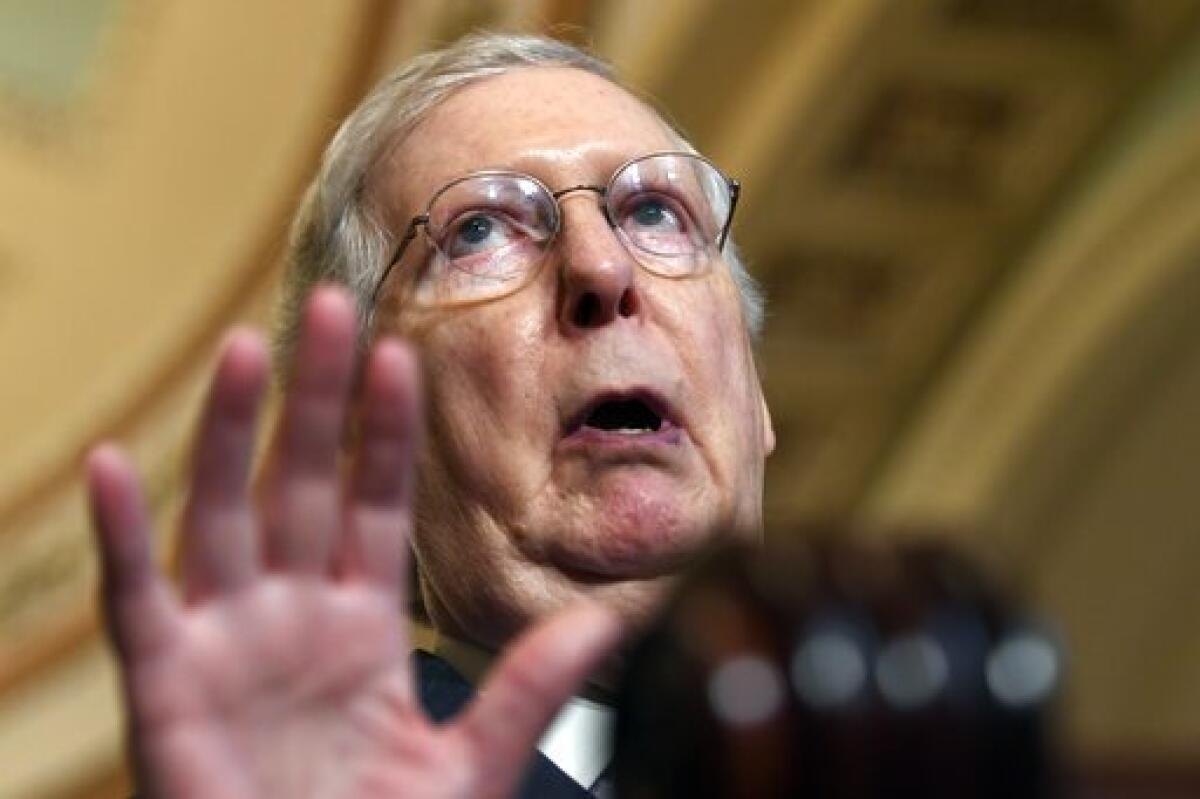
- Share via
For some reason, the fiscal crisis engulfing states and localities due to the COVID-19 pandemic has the power to cloud Republicans’ minds.
There could be no other explanation for the resolute disdain shown by the GOP congressional caucus toward the $350-billion provision of state and local aid in President Biden’s $1.9-trillion pandemic relief proposal.
“This is no time to send wheelbarrows of cash to state and local governments that they simply, factually, do not need,” Senate Minority Leader Mitch McConnell (R-Ky.) huffed earlier this month.
The states aren’t out of the woods yet.
— Brian Sigritz, National Assn. of State Budget Officers
“By the way,” he added, “state and local tax receipts already fully rebounded in Q3 to their highest level in American history.”
Sticking a shiv into the very concept of bipartisanship on Capitol Hill, McConnell’s press release attacking the state and local aid provision bore the heading, “Democrats Are Yet Again Pushing Massive Bailouts For Big-Spending States.”
It’s hard to pinpoint where McConnell gets his information, but the best that can be said about it is that it’s cherry-picked.
State revenues are expected to fall by 4.4% in fiscal 2021 (that is, from July 1, 2020, through June 30, 2021, including the third quarter of 2020) compared to “already depressed fiscal 2020 levels,” the National Assn. of State Budget Officers reported last fall.
That would mean a drop of 10.8% from revenue projections in pre-pandemic budget proposals, the association said.
States and local governments face a revenue shortfall of $200 billion to $300 billion through fiscal 2022, the Center on Budget and Policy Priorities calculated this month — and that’s assuming they wipe out all the rainy-day savings they had accumulated before the pandemic struck.
The pandemic is destroying state and local budgets, as GOP refuses to help.
As for the assertion that Biden’s pandemic relief would be a handout to “big-spending” (read “Democratic”) states, it’s true that California would receive the largest share, $41 billion, according to a Democratic markup of the proposal.
That’s because California is the biggest state. The second-biggest recipient would be red Texas, getting $27 billion; red Florida comes in fourth, at $16.5 billion. The pandemic has been a bipartisan fiscal threat.
The sleight-of-hand stunt McConnell is offering his audience is that states and localities have done better fiscally than anyone expected in the first months of the pandemic.
Get the latest from Michael Hiltzik
Commentary on economics and more from a Pulitzer Prize winner.
You may occasionally receive promotional content from the Los Angeles Times.
“A lot of states sharply reduced revenue forecasts downward immediately after the outbreak of COVID-19,” Brian Sigritz, NASBO’s director of state fiscal studies, told me.
For a variety of reasons, the most dire expectations didn’t come true. But in the majority of states, revenue still hasn’t recovered to pre-pandemic levels.
“Money is still tight and states still need to respond to COVID-19,” Sigritz says. “The states aren’t out of the woods yet.”
Another misleading factor is that the national picture of state and local finances is skewed by a single outlier: California.

Last May, as legislators and Gov. Gavin Newsom crafted the 2020-2021 state budget, “they were projecting a bloodbath,” Byron Lutz, a fiscal analyst for the Federal Reserve Board, told a Brookings Institution webcast audience on Feb. 10.
“They thought they were going to be down $30 billion relative to their pre-pandemic projection” of about $153 billion in state tax and fee revenues, Lutz said.
By November, however, budget analysts were projecting a windfall of some $26 billion instead. That was eventually revised to about $15 billion.
For the GOP, deficits only matter when there’s a Democrat in the White House
Several factors contributed to the pleasant surprise. One was the infusion of billions of dollars in congressional pandemic aid, including enhanced unemployment benefits, stimulus checks to most households, and other assistance.
Every state got a piece of that pie, of course. But California’s tax system also delivered gains. The state is heavily reliant on a progressive personal income tax, which held up well in part because a buoyant stock market generated billions in capital gains tax revenues.
States without an income tax and consequently more dependent on regressive sources such as sales taxes didn’t have that cushion.
The diversification of California’s economy also helped. Two categories of states have seen the largest shortfalls of revenue relative to pre-pandemic expectations: those dependent on energy and thus vulnerable to the fall of oil prices (such as Alaska, North Dakota and Texas) and those dependent on tourism (Hawaii, Nevada and Florida).
Still, budget analysts warn that the windfall California saw in the last fiscal year and the current year is unlikely to last.
Revenues from the state’s three largest taxes — on income, sales and property — are expected to grow by only about 1% a year in fiscal 2022 and later, rather than the 4.4% annual gain baked into budget projections. The result, the Legislative Analyst’s Office forecast in November, will be an annual deficit rising to as much as $17 billion by 2024-2025.
For all that McConnell and his ilk denigrate state and local aid as bailouts to blue states, four of the states mentioned above are politically blood-red.
Virtually every state has suffered from the pandemic’s short-circuiting of previous budget expectations, Lutz observed. In the two years before the pandemic, states had been experiencing annual increases averaging about 5%.
“They had every reason to expect this growth to continue into 2020 and beyond, and they budgeted in that manner,” Lutz said. Even though revenue has been flat for 2020 compared to 2019, he said, “that was a large decline relative to what their expectations were and that opened up large budget holes.”
The other side of the state and local fiscal coin is spending. Prospects for demands on state budgets are grim. Public health, social services and education are all responsibilities of state and local government, and costs in those sectors are exploding.
The rift between the experience of those able to work from home and those in the service sector, now out of work, shows how the coronavirus outbreak will only exacerbate income inequality in America.
Hardening communities against the transmission of the COVID-19 virus takes money, as does providing treatment — some of which may be required for years or even a lifetime — for low-income residents. Administering screening tests and vaccinations are another cost.
Families that have lost their breadwinners’ income because of illness, death or joblessness will require help from social services.
As schools prepare for reopening, they’ll need to upgrade school buildings with costly high-efficiency heating and ventilation systems to protect against viral spread, and provide school workers with personal protective equipment.
The educational deficit caused by keeping children out of school for a year or more will also impose long-term costs through the need for remedial programs.
The combination of lower revenues and higher costs has already produced a massacre in state and local employment. In the year ended Jan. 31, state and local governments shed roughly 1.3 million jobs.
More than 900,000 of those jobs were teachers, most of whom can be expected to return to work as schools reopen; but the rest include police officers, firefighters and administrative employees.
The damage done to state and local budgets has been largely concealed by the unusual nature of job losses. Unlike the pattern of economic downturns such as the Great Recession, unemployment due to the pandemic has been concentrated among low-income workers.
For income-tax states such as California, this has moderated the fiscal pain, since low-income workers contribute proportionately less in income taxes than wealthier taxpayers — who had better luck holding on to their paying jobs, too.
The opponents of more state and local relief overlook the fact that one reason state and local governments have done better than expected over the last year is that the huge federal pandemic relief spending kept their economies out of deeper holes. That’s an argument in support of continuing the spending, rather than risking a premature cutoff.
A good portion of the state and local relief already enacted, including $100 billion provided from a relief bill passed in December, was funneled to specific needs, such as K-12 education and transit programs.
More of such pigeonholed aid is certainly needed, especially for healthcare and anti-pandemic programs. But states and localities are also clamoring for funding they can spend flexibly, where it’s most needed. That’s the spending that McConnell opposes most fiercely.
The U.S. economy appears to have gotten through the worst of the pandemic in surprisingly good shape. But it’s living on a knife edge. Without more aid, state and local governments will be forced to draw their belts tighter.
That means fewer municipal workers, more deferred maintenance of roads and bridges, and less disposable income for everybody.
The time will come when the economy can stand on its own two feet without more infusions of federal capital, but we’re not there yet.
More to Read
Inside the business of entertainment
The Wide Shot brings you news, analysis and insights on everything from streaming wars to production — and what it all means for the future.
You may occasionally receive promotional content from the Los Angeles Times.

